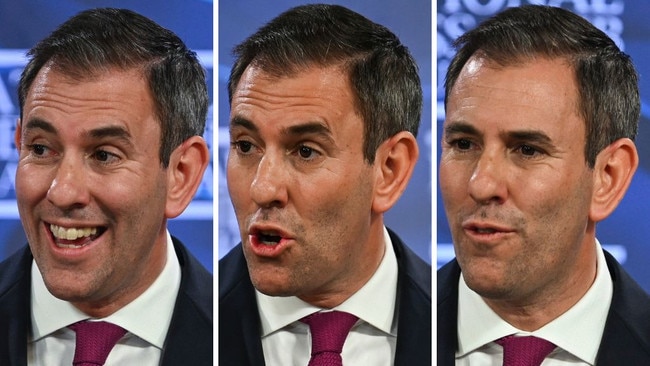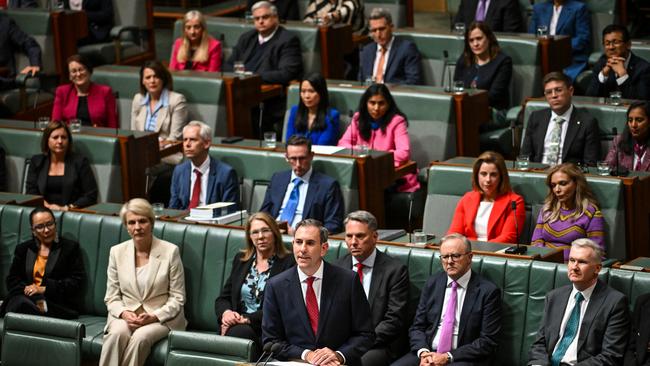The budget speech Jim Chalmers should have given
If the Treasurer made the tough calls on spending he could have bagged a surplus and become a Labor hero.

That’s why tonight I can announce our prudent policies will put us on track for another surplus in 2024-25. If we stick to our guns, grow the economy and continue to make government more efficient, we may even be able to shoot for another one the following year.
Treasury’s commodity prices forecasts, as usual, are conservative. But every dollar of future revenue upgrades will go to the budget’s bottom line.
Four surpluses in a row would surpass Paul Keating’s grand achievements in the 1980s.
This budget will revive Labor principles that have made our nation wealthy, competitive and fair.
Open markets, living within our means, growing the pie by developing our talents and embracing new technologies, and a secure social safety when people are at their most vulnerable.
We will invest in cleaner energy and strengthen industrial capacity in our areas of comparative advantage, so that we can secure a more prosperous future together.
And we won’t waste taxpayer money on things that don’t meet strict tests. Investments must promote net zero or build economic resilience and security.

The starting point is how we tax and spend. Tonight, I’m announcing new fiscal guardrails.
For too long, our political opponents have taken the short-term view. That somehow the budget can fix every problem, guarantee every outcome, prop up every personal circumstance.
Budgets can’t do that.
They need to attain a balance over time through the bumps of the economic cycle and not burden future generations with debt for today’s lifestyle. Fiscal policy is the ballast and we should rebuild our buffers in relatively good times, like now when our export prices are at 100-year highs, so that we can respond with vigour and vim in crises like the GFC and pandemic.
The independent Reserve Bank’s monetary policy is the best tool to smooth out economic activity in the short term and contain price pressures. RBA governor Michele Bullock said last week that inflation is still too high. It’s our No.1 problem. Inflation is falling, but there are challenges in bringing it back to within the central bank’s 2 to 3 per cent target band in a reasonable time.
As the IMF said recently, if we co-ordinate our response to the problem, we can beat back inflation and stay near full employment, which would be a wonderful achievement given the disruption and distress of the past few years.
We are doing everything we can to make sure we are supporting its inflation-fighting and employment mandates by not running an expansionary fiscal policy, which would simply fire up demand and reignite inflation.
The Albanese government will be restoring the strict fiscal rules introduced by Wayne Swan 15 years ago. We will cap real growth in spending to 2 per cent a year on average until the surplus is restored to 1 per cent of GDP, the level we achieved in our first budget.
All new spending in this budget has been offset, including in the national security and education portfolios, where taxpayers have not been getting value for money.
When we came to office two years ago, the budget was deep in deficit. We supported the temporary and targeted emergency health and income support measures.
But in our first budget we also needed to get rid of Coalition rorts and waste, as well as fill the funding holes they left for vital programs.
We did that. We returned almost all of the revenue upgrades to the budget’s bottom line to deliver the first surplus in 15 years.
We did it again in our second budget, with a plan to keep annual real spending growth to 0.6 per cent, on average, over five years.
But the medium-term pressures on spending from aged care, health, defence, disability services and the Coalition’s debt interest bill meant spending would have to rise.
It was unavoidable, as Treasury confirms in the budget papers. We were not prepared to cut frontline services, so we have made the hard calls on non-essential programs.
Six months ago, we estimated budget deficits would amount to over $100bn this year and the coming four years. The underlying cash balance was projected to improve, but we would still be in deficit 10 years down the track.
We had to act. There was pressure to drop the stage three tax cuts, but we redesigned them to make them fairer and put more money back in the hands of low and middle-income earners. From July 1, there’s a tax cut for every taxpayer.
At the mid-year review we were facing a $19bn deficit and two years of spending growth of 2.5 per cent.
We have stuck to that task and Australians will reap the benefits.
It was not easy. Labor governments think big and act accordingly to make Australians the beneficiaries of change. Every minister who came to the expenditure review committee had a list of great ideas. But we could not fit them into our funding envelope.
We’ve made difficult choices.
It means we’ll be looking for greater efficiencies from the public service, the care sector and defence industries. We will bring forward a review of the GST distribution.
We have a great opportunity to refine the National Disability Insurance Scheme so cost growth in the years ahead is manageable, by limiting entry to the scheme, working with our partners in the states and territories, and capping the inflationary impulse in individual plans.
Reform of aged care is an opportunity to be innovative and consultative while providing choice and dignity for older Australians. We are working with the community and the parliament to make the system more sustainable. Those who can afford to do so should make a contribution to their care.
Australians are under the pump. The indexation of welfare payments during this period of elevated inflation means we’ve maintained support. We’re raising commonwealth rent assistance and building 1.2 million homes.
While some state governments are offering energy bill rebates, we can provide assistance only to the most vulnerable at this time.
A 2 per cent cap on spending matches the average growth in GDP we expect in the next few years. It is also the growth rate Treasury projected for the coming 40 years in last year’s Intergenerational Report. Spending should not grow faster than the economy, especially as the prices for our exports settle back to their long-term averages in coming years.
Labor won’t settle for tepid growth and stagnant living standards. Over the past 30 years, through the churn and change of the global economy, we have averaged growth of 3 per cent a year.
Our opponents will stumble and scramble on the low road, and shun the dynamism and innovation from the world’s best talent.
Labor will aim higher. That’s because unlike the Coalition that presided over a decade of drift and deficits, with no productivity growth and falling real wages, our policies will raise the nation’s potential and performance.
We are reforming competition policy, making it easier for workers to switch jobs and earn higher wages. We’ll make sure mergers don’t lead to price gouging and lazy ticket-clipping.
We’ll remove regulations that hinder nation-building projects and nurture start-ups that will grow into world-leading companies and take our young people to the frontier of technological discovery.
A Future Made in Australia is an idea that is at the heart of the Prime Minister’s purpose in public life. It is simply a modern “Australian Made”. We want the world to have the best of what we can do.
As a mid-sized trading nation, it’s how we got rich. We don’t have the industrial scale of China, the US, India and the eurozone. Or their local markets.
But they are our customers for critical minerals and suppliers of the things we can’t make here, such as electric vehicles and planes.
Net zero by 2050 and strategic competition have transformed national economies. Global trade is fragmenting, so there are new risks, including for accessing key technologies for the energy transition.
But there are immense opportunities as well. As Treasury explains, countries are responding to the extreme concentration of solar and battery supply chains by implementing incentives to drive domestic manufacturing. Australian consumers will benefit from any improvement in supply chain diversity and competition.
Subsidised by foreign taxpayers.
We will continue to leverage our capabilities in research, discovery and development, as well as commercialising new technologies, especially those relevant to our unique conditions and strengths.
That will reduce critical economic vulnerabilities and provide an important contribution to Australia’s trade partnerships.
Treasury has designed a National Interest Framework to avoid the mistakes of the past, when taxpayers subsidised industries that could never stand on their own feet.
We are learning as we go and if we judge that a previous commitment does not meet our rigorous new assessment process we will not risk precious public money.
Speaker, we are realistic about the challenges we face. Yet the Australian story is not simply one of endurance and mastering adversity.
We are an ambitious, confident, creative and compassionate people. There are always more optimists than pessimists. Don’t ever bet against Australia’s future.
Because we start from a place of hope, abundance and strength. Our debt levels are low by global standards and our institutions are robust and flexible. Our foundations are strong.
We are a trusted partner in the world and a welcoming nation for its diverse peoples.
We have social stability, natural resources, skilled workers and a continent to ourselves.
We’re a magnet for the world’s young talent, including those who are developing the breakthrough technologies in quantum computing and clean energy.
This restrained and responsible budget will raise our potential and prospects, ensuring we pay our own way, while holding firm to our tried and tested values.
A fair go for every industry, state, worker and citizen.
A third surplus means we have our feet firmly on the ground in this defining decade.
As we create a new economy.
We are reaching for the stars and securing a new generation of promise and prosperity. And that’s why I commend this bill – and this budget – to the house.





Speaker, in these difficult days this is a responsible budget that secures the nation’s future. It will help to reduce inflation, which is the main driver of today’s cost-of-living squeeze on families, and it will restore fundamental rules to the way we do budgets in Australia.